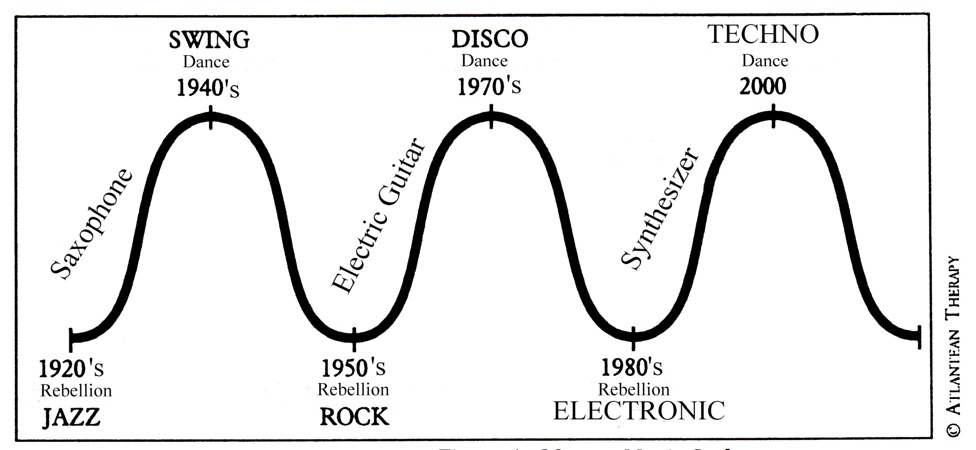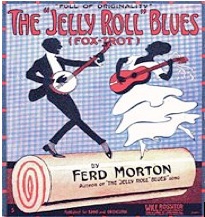Father & Daughter Film Report
“It is a test of true theories not only to account for, but to predict phenomena.”
- William Whewell (1824)
In 1983 when the president of EMI in Hamburg discovered dad was the astrologer in the weekly magazine Bild der Frau (Pictures for Women), the question arose:
What is the future of music?

Dad found a historical cycle within the context of popular American music that repeated every 30 years. The graph below published in his first book (1998) illustrates this 30-year cycle and how this cycle repeats itself historically in a very regular, and precise, pattern, revealing elements that define, and can be used as predictive tools, within each cycle.
One element is the evolving electronic complication of the instruments, and how the new sounds from these new instruments create a rebellion phase (when a style is rejected by most of society) and the dance phase (when a style is accepted by most of society).

Each cycle begins with a new category, which can be described as a new form of technology (or instrument) becoming associated with and affecting the new style of music created within this cycle. For example, the saxophone’s input with a certain cultural group’s experimental music of the 1920’s evolved into Jazz, the electric guitar in the 1950’s generated one of the defining elements of Rock & Roll, and the synthesizer became the foundation of the 1980’s electronic music.
Another category is the phases in which the cycle develops, and then fades away. For example, in the early 1950’s, Rock & Roll becomes the new ‘rebellious’ music for disfranchised youth (while being shunned by the rest of society) and then after 20 years, evolves into being the most popular form of music: the style of music most danced to, as well as used in commercials, film, and television productions.

Creole pianist Jelly Roll Morton's published "Jelly Roll Blues" in 1915, is considered the first jazz work in print.
Each cycle begins with a new category, which can be described as a new form of technology (or instrument) becoming associated with and affecting the new style of music created within this cycle. For example, the saxophone’s input with a certain cultural group’s experimental music of the 1920’s evolved into Jazz, the electric guitar in the 1950’s generated one of the defining elements of Rock & Roll, and the synthesizer became the foundation of the 1980’s electronic music.
Another category is the phases in which the cycle develops, and then fades away. For example, in the early 1950’s, Rock & Roll becomes the new ‘rebellious’ music for disfranchised youth (while being shunned by the rest of society) and then after 20 years, evolves into being the most popular form of music: the style of music most danced to, as well as used in commercials, film, and television productions.
Glenn Miller specialized in having his clarinet play a melodic line with a tenor saxophone on the same note, while three other saxophones harmonized within a single octave.

The core category that ties the previously mentioned categories and properties of this 30-year cycle together is the planet Saturn, whose own orbit is on average 29.7 years, and appears to reflect the changes in the technology as well as both phases categories within each cycle (Perkins, 1998). For example, Saturn moved into the zodiac sign of Scorpio in the early 1920’s, 1950’s, and 1980’s, which coincides exactly with the rebellious, or rejected phase, and then moved into the sign of Taurus in the early 1940’s, 1970’s, and in the year 2000 to coincide exactly with the dance, or accepted phase.
Besides the exact timing equivalents of the planet Saturn moving into each sign, the characteristic of each sign (Erlewine, 2006) also matches the characteristic denoted within each phase. For example, one defining characteristic of Scorpio is sex (Erlewine, 2006), and the driving force of youth - sex - can also be seen as a defining characteristic within each cycle of the rebellion phases. O'Meally (1998) notes that not only is the association of jazz and sex early and extensive, but at it very core, jazz is sex. The same can be said of a young Elvis Presley, whose sexual gyrations (censored at first on national TV) in the 1950’s is a strong illustration of the sexual implications associated to the following cycle of Rock & Roll.

Saturn in Scorpio tends for sexuality to be at the heart in the creation of popular music.
Saturn entering Taurus, a sign that represents “money” (Erlewine, 2006), also shares association with the dance phase of a cycle, for when a particular style reaches the height of its popularity, and is used in commercials, film, and television productions, money becomes more of the creation issue than raw youthful expression. Each phase in relation to Saturn can also be verified by external associations of Saturn with other planets (Perkins, 1998) since Saturn incurred both strong aspects with Venus and Jupiter (by 90° and 180°) in the beginning of both the rebellion and dance phases.
The evidence of this 30-year cycle then offers the practitioner a predictive tool using; for example, by extending this pattern one can visualize the next new style of music to begin developing around the year 2010. Note: actually around 2015 - for even though the current new style is already under development in the basements and garages across America, several years are needed for this new ‘raw’ form of music to enter mainstream music outlets. For example, the identifying iconic Rock and Roll song “Rock Around the Clock” (Freeman & Myers, 1952) did not become popular until its rendition by Bill Haley and His Comets until 1954, even though the elements of rock and roll were being experimented with several years earlier.
Further predictions can be made using these same categories of this current cycle that started recently to make the prediction that the dance phase of this current cycle now underway will occur in the year 2030.
How else can such information be used...?

Currently dad is using the data to assist in the musical selections for his latest award winning screenplay:
determining which songs of the past would remain popular for today's film audiences.
Check out the Musical Selections by clicking the link below:
- Amanda Perkins

